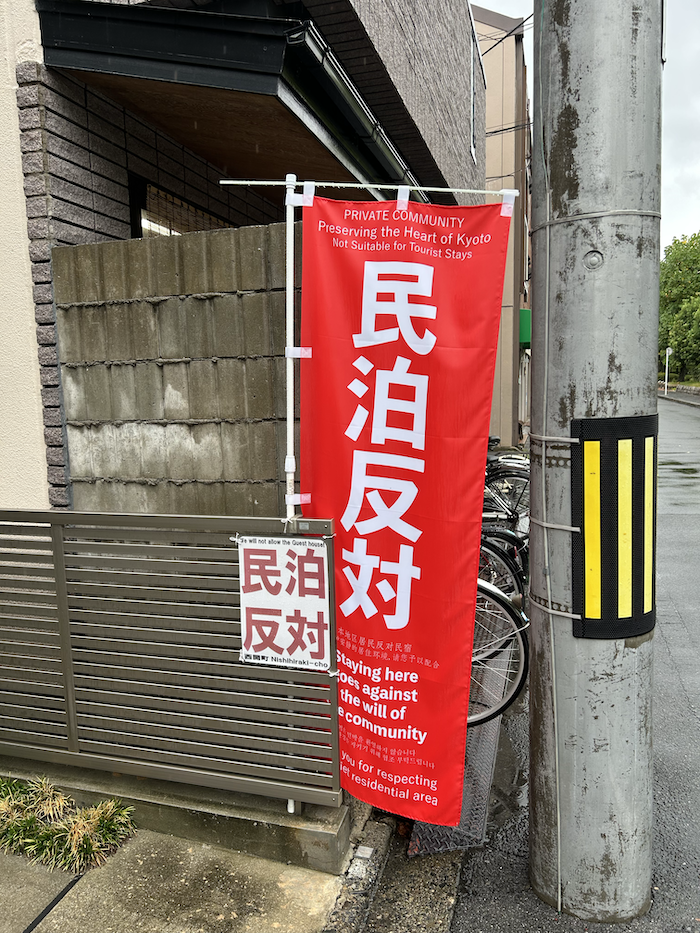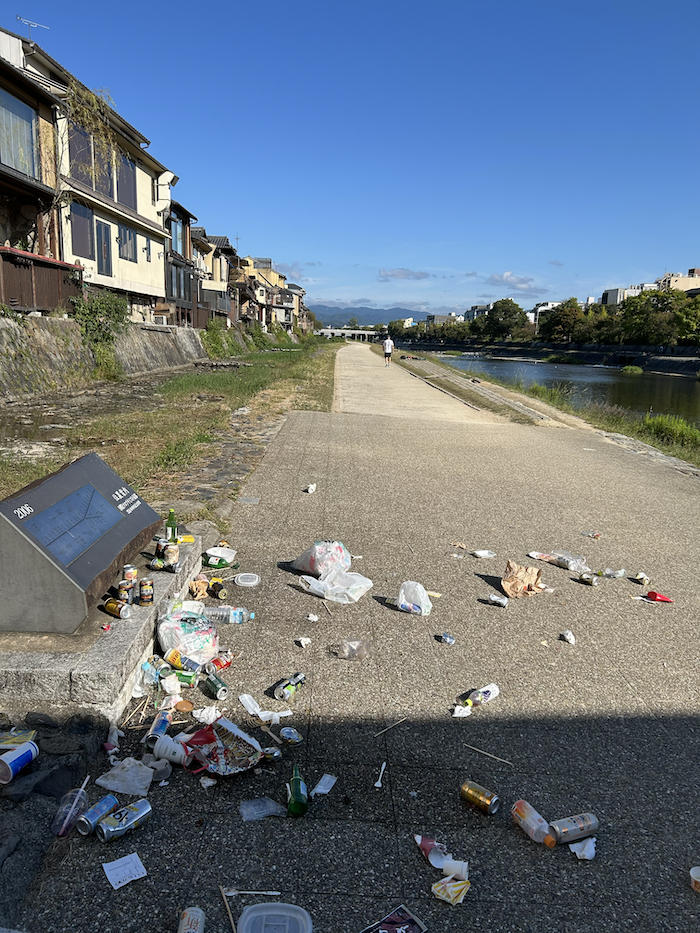The Prime Minister's Office of Japan has now released the transcript of the - Policy…
Kyoto Report 2025 – 3
This Tuesday report will provide some insights into life for a westerner (me) who is working for an extended period at Kyoto University in Japan but who over the years of working here has increasingly began to understand the language and local cultural traditions
Growing hostility to tourists in Japan
I was out running early the other morning through the suburb where I live on my way to the river.
It is a northern suburb well away from the Tourist mecca of Gion and Yasaka etc.
The surrounding neighbourhoods are quiet and clean and one rarely sees a tourist walking around there.
Then I came across this sign – and many more like it.
The main sign reads: Opposition to Private Lodging.
I saw some friends for lunch a bit later, one of which lives in the locality too and she explained that it was an Airbnb proposal to take over a building and convert it into short stay accommodation.
I learned that locals are starting to organise to kick these short-stay places out of their neighbourhoods.
The locals feel that the tourism is over the top and disturbing their neighbourhoods.
I took this photo further south on the Kamo river bank closer to the main shopping district, which tells you what the locals are talking about.
The tourist flood, of course, is two-sided.
On the one hand, it is providing employment and wages growth for the cities.
A friend, who works in a Kimono hire shop told me the other day, she has never been busier.
But on the other hand, the tourists often are an assault on the culture and serenity of the neighbourhoods.
I saw two tourists on the train the other day in shorts and singlets, covered in tattoos, talking above the rest of the carriage.
All aspects of that were highly insulting to the other travellers.
That is happening right across the tourist areas in Kyoto.
As an aside, the reason that my swimming club asks about tattoos (reported last week) is mostly due to the – Yakuza exclusion ordinances – which were aimed at ridding Japan of the criminal gangs.
They have been very effective since the first of these laws came into effect in 2010.
The yakusa numbers have shrunk significantly and eventually they will die out.
The Genkan (玄関)
Houses in Japan have an entrance area – Genkan (玄関) which is considered the transitional space between the street (unclean) and the living quarters (clean).
The genkan is designed to be lower than the rest of the flooring inside the house and the step (shikidai 敷台) can keep dirt from blowing in.
The tradition is that people take their shoes off in the genkan and slip on some house slippers to maintain cleanliness in the house and a demonstration of respect for the owner and the building.
Often there is a shoe rack/shelves or a special shoe cupboard (getabako 下駄箱) provided for even neater placement.
There is also usually an umbrella rack and a coat rack in the genkan.
All that is readily understandable and it applies in houses elsewhere including Australia, although our practices are less strict.
This architectural tradition started, it seems, during the Edo period (1603-1868), as a sign that the owners had means or social status.
Lower classes did not have them in their homes – only samurai, aristocrats and high-ranking public officials.
Considerations of cleanliness progressively overtook the social class angle and the genkan became universal.
And, one doesn’t walk around the genkan in one’s socks.
This necessitates a rather strategic dance involving taking one’s shoes off, placing them strategically in the genkan and then hopping into the main house without touching the genkan floor with one’s socks.
But the nuance is that when one takes the outdoor shoes off, they are placed on the genkan floor with the toes facing the door.
Why you might ask?
That is to make the reverse dance easier to accomplish as one can just step straight into the shoe from the upper level.
That is enough for today!
(c) Copyright 2025 William Mitchell. All Rights Reserved.


Geez. What pigs that tourists, (many Americans probably?) are. That is a common site here in the US. We neither have respect for ourselves much less other cultures. As evidence especially with our foreign policy.
Really like your travelogue as I do a public television series called Journeys In Japan.
I have done three long road trips in Australia over the past two years. I’ve just completed a one-month trip in Western Australia, having driven from my home in Adelaide to Perth for a 60th birthday party. It was the first time I’d driven across the Nullabor Plain. It turns out that the ‘treeless plain’ of the Nullabor is a myth, at least along the main highway, which is close to the coast, unlike the train trip which is much further inland. There is only a 30-40 km section that could be described as devoid of trees. It’s a long drive, especially on your own, but worth it. The Bunda Cliffs at the Head of the Great Australian Bight are breathtaking (Lookout No.1 on the South Australian side of the border is the best), and I spent an entire day watching Southern Right Whales (including Mums and their calves) at the whale-watching platform. After attending the birthday party in Perth, I spent three weeks along the south coast of WA. One runs out of superlatives to describe the scenery. Mother Nature on full display – both her beauty and her bounty. Tall timber for miles and miles (Karri and Tingle forests), spectacular coastline (beaches, sometimes all to yourself), beautiful inlets, wild rivers, and wildflowers. I was surprised at the lack of tourists, and thankful for it.
Many Australians are unaware of what is in their own backyard and go overseas for holiday breaks at the drop of a hat. That said, some of the magnificent places I saw are attracting ‘tourists’, especially those promoted in the tourist brochures (tourists ignore other places, which are often better). Fortunately, most tourists do their sightseeing between the hours of 10.00 am and 3.00 pm, which, for someone like me who enjoys photography, I don’t have to worry about pesky tourists getting in my photos when the light is at its best (early morning and late afternoon/evening).
It’s fascinating to watch ‘tourists’ as opposed to ‘travellers’. The tourists treat a walk to a mountain top as a ‘destination’. Travellers treat it as a ‘journey’. The former rush up to the top of the mountain, take a few selfies to post on Facebook, and rush back down again. They completely ignore the magnificent vistas you get as you ascend (which you don’t always get at the top of the mountain) and the beautiful and changing vegetation along the way, which was a blaze of colour in some places. I took all day to do the walk up and down Bluff Knoll in the Stirling Range. People gave me strange looks as I took photos of the trackside vegetation and thought I must have been decrepit for taking so long, having passed me on the way up and way down.
I, in fact, hate mass tourism. I suppose my mere presence as a traveller contributes to the large numbers of people placing pressure on special and often fragile places. But I tread carefully and feel that I am going to places to appreciate them rather than to be able to say, “I’ve been there”, as so many tourists do. A couple of years ago, when I declined an offer for someone to take a photo of me with my camera (I had just agreed to take a photo of a small group at a location), a person said to me, “How are you going to prove that you’ve been here?” I can’t remember my response, but I remember thinking that the question summed up many people’s reasons for going somewhere – simply to rule a line through a place on their bucket list, not to experience and enjoy. These people must sort through their photos when they return home to remember where they’ve been – no visual images of the places they’ve visited whatsoever.
Most tourists don’t respect the places they visit; they treat National Parks as playgrounds (climb over everything); many leave rubbish behind; and ignore the park rules. Here’s some advice. Don’t bother going to Mossman Gorge in Far North Queensland, Echo Point in the Blue Mountains in NSW, or Loch Ard Gorge along the Great Ocean Road in Victoria if you want to avoid hordes of people in order to experience the beauty and serenity of a place. No chance whatsoever thanks to busloads of annoying tourists.
Tourism (foreign visitors) is an export, and exports are costs. The people of a nation hand over some of their country to foreigners who, in large numbers, despoil places. Local tourists in large numbers showing no respect for the places they visit exacerbate the problem. Tourism is becoming one of the costliest exports. Just ask most of the residents of Barcelona and Venice.
Bill
Latest comment from another Guardian economics commentator reads
“The political reality is if we want a better, more equal society, the government needs to raise more tax to pay for better public services and benefits.”
https://www.theguardian.com/commentisfree/2025/oct/09/more-equal-society-we-need-more-tax-only-works-when-big-business-pays-fair-share